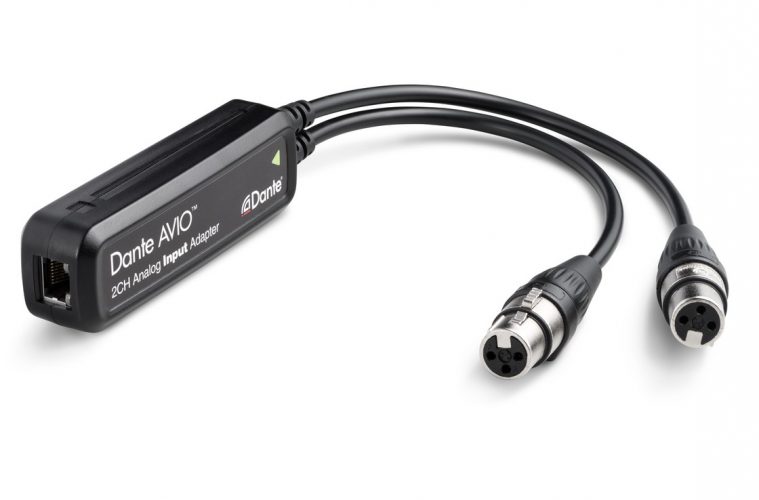If you’ve attended any NAMM Show, there’s a good possibility you’ve heard the word “Dante” mentioned somewhere on the show floor. It’s likely to be mentioned at The NAMM Show this month as well.
Dante is an innovative technology that allows the transmission of up to 512 channels of uncompressed, high-quality audio over a single Ethernet cable. What makes it groundbreaking is that customers can dramatically reduce the cabling required for their audio gear, while at the same time have tremendous flexibility on where to route the audio since connections are done in software rather than “point-to-point” cabling.
At the forefront of Dante is Audinate, which introduced Dante AVIO, a family of cost-effective endpoint adapters that enable audio professionals to easily connect legacy analog and digital audio equipment to Dante networks. The Dante AVIO series features six new adapters, including line-in and line-out analog adapters, a bi-directional AES3/EBU adapter and a bi-directional stereo USB adapter.
Each Dante AVIO adapter acts as a completely independent Dante network device, allowing legacy gear to enjoy the benefits of networked audio. These devices can now seamlessly transmit high-quality, uncompressed audio streams over long distances without the noise and ground issues common to analog connections.
“The idea behind AVIO was to bring the benefits of Dante networking to the plethora of legacy analog and digital devices in the audio world,” Joshua Rush, senior vice president of marketing and product development for Audinate, told the Music & Sound Retailer. “While it would be great to have customers upgrade their gear just to get Dante functionality, we know that oftentimes that doesn’t happen, at least not right away, and customers needed a bridge in the meantime. The family of AVIO adapters came from looking at the particular types of products that customers were wanting to network, and the types of connectors that were necessary to bring those signals on and off of a Dante network.
“The initial family of adapters consists of 1-channel and 2-channel XLR line-level input adapters that could be used to network a wireless microphone base station, DI box or a 2-channel feed from a mixing console,” he continued. “There are also 1- and 2-channel XLR output adapters that allow end points, such as powered loudspeakers and amps to also be networked. The portfolio of adapters also includes a bi-directional USB adapter, to easily network computer-based audio, and a bi-directional AES3 adapter for connecting legacy AES3 products.”
There are two main pain points that AVIO solves for customers, added Rush. “The first is for those already using Dante networking,” he said. “These adapters provide an easy way for these customers to add more equipment and instruments onto their Dante network, which makes their whole audio setup more powerful and flexible than it was before. The other group consists of customers who haven’t used networking before. Most legacy analog and digital cabling has serious limitations. USB, for example, is not a viable option when you have to run cables longer than 10 feet, or analog XLR cables which can suffer from noise, hum and signal degradation over longer distances. Dante AVIO provides an easy and cost-effective way to bring the benefits of audio networking to these audio projects.”
Thus far, feedback on the AVIO has been overwhelmingly positive, Rush confirmed. “Probably the single biggest thing that our dealers like is the price. With the adapters starting at $129, they are by far the most cost-effective way to add the benefits of networking to audio products.”
Positive feedback certainly makes sense, as Audinate had a customer-centric process when it came to designing the AVIO series, as well as when manufacturing all other products. “Whether we are looking at new features for the core Dante technology or brand-new products, we want to make sure we are truly solving real-world problems and making our customers’ jobs and lives easier. Sometimes, new ideas are a direct result of feedback from customers, and other times ideas come from spending time with customers to understand their pain points, so we can envision solutions that may not have been obvious to them. Either way, the ideas are put through a rigorous product management process that defines the solution and validates the business opportunity. Then we develop, test and launch the product. Customers are involved every step of the way.”
Looking ahead, Rush said Audinate is “always incorporating customer feedback in the product development process, and we have certainly heard a lot of ideas for additional adapter types. While we don’t have any more in development right now, we will continue to evaluate these new ideas and their viability in the market.”
As for today, Audinate is supporting the sales of AVIO with a comprehensive marketing campaign that includes digital advertising, social media advertising, public relations and reviews. “We have also been working with select dealers on account-specific marketing activities. We will have the complete family of adapters on display in our booth at NAMM (Booth 18505).”
Audinate offers AVIO in six models: 1-Channel Analog XLR Input: MSRP $129; 2-Channel Analog XLR Input: MSRP $169; 1-Channel Analog XLR Output: MSRP $129; 2-Channel Analog XLR Output: MSRP $169; 2-Channel Bi-Directional AES3: MSRP $169; and the 2-Channel Bi-Directional USB: MSRP $129.


